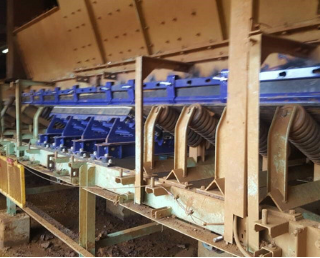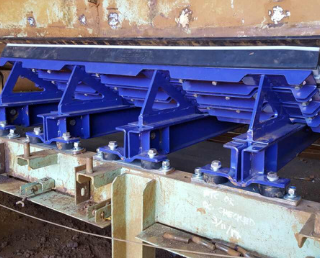How Protecting Your Load Point Can Increase Your Productivity
 The belt sees every ton of product. It’s amazing they last as long as they do. By the same token, the load support sees every ton, too. Ensuring your load point is effectively protected has a great effect on the productivity of your entire system. With the right load point support, you could see improvements in belt wear, product loss, dust, spillage, mistracking, and less damage to your equipment.
The belt sees every ton of product. It’s amazing they last as long as they do. By the same token, the load support sees every ton, too. Ensuring your load point is effectively protected has a great effect on the productivity of your entire system. With the right load point support, you could see improvements in belt wear, product loss, dust, spillage, mistracking, and less damage to your equipment.
Just as one large pothole can wreck your tire, one large rock can wreck the load support and the belt if it exceeds the design capacity. That’s why, when you’re choosing a support system for your load point, it’s important to consider abnormal conditions. For example, the same belt that runs 6” (150 mm) minus coal, could also have 300 lb (140 kg) slabs fall on it too, highlighting why having the right protection for your load point could help protect your belt, reduce those time-consuming maintenance problems, and limit unscheduled downtime in your facility.
Challenges in the load point
Once in the impact area, there are several challenges that can be addressed to improve the load point. Every load zone needs consideration given to selecting proper support of the belt. Sometimes impact idlers are enough, while others may need a sophisticated impact bed to provide the required protection for the belt.
Dust is also an important issue many industries deal with, not only due to the major risks it can cause the safety of workers who are exposed to breathing in dust or other finely powdered material into their lungs and airways, but also, dust is essentially wasted product that is causing significant time spent cleaning up and maintaining damaged equipment. As a result, sealing the load zone from escaping dust and spillage will also be a consideration for selecting a belt support solution.
In many cases, there is simply not enough support for the belt in that area. Some common examples of this problem include not using impact idlers or beds; spacing impact idlers too far apart, which creates gaps in the seal that can cause spillage; catenary idlers that have too much “give,” which can cause belt damage and spillage; and mistracking caused by off-center loading at the impact point.
Selecting and implementing the right load point solution
 Keeping these issues in mind, you will want to make sure the belt is continuously supported. A proper impact bed can be the solution to all of these challenges, but you’ll need to make sure you have all of your specifications correct. It’s important to know and account for the largest material lump weight and drop height as this is essential to choosing the appropriate bed for your application that can handle the toughest conditions.
Keeping these issues in mind, you will want to make sure the belt is continuously supported. A proper impact bed can be the solution to all of these challenges, but you’ll need to make sure you have all of your specifications correct. It’s important to know and account for the largest material lump weight and drop height as this is essential to choosing the appropriate bed for your application that can handle the toughest conditions.
When the largest material lump weight and the drop height numbers are multiplied together it will provide the impact force for your application. Once you have this information, make sure that your solution’s ratings are never lower than your calculated impact force.
A simple and informative impact bed calculator can help you make the right decisions for your application. Start by choosing your unit preference, metric or imperial. Then, simply input your belt width, drop height, select the material you are conveying and its solid density, the largest lump size, the flow rate. You’ll be able to instantly view the calculated impact energy of your specific application, and view suggested impact beds that would be most effective in your application. You can find this calculator on this page, then click the button for impact bed calculator.
All too often beds are placed to fit the receiving conveyor or chute rather than the material flow. When installing an impact solution you should pay close attention to where the material is hitting the belt and install the load point solution in such a way that the material flow lands in the center of the load point solution. For example, an impact bed with material flow landing at the very end of the bars may not perform up to the specified rating and it may also experience premature wear.
While dust suppression systems are an common choice for many facilities in their battle against dust, they have their limitations when it comes to the areas they can control, plus, any product captured by a dust suppression system is not going back into the system and remains wasted product.
A very simple solution is an enclosed skirting system. Not all containment solutions should require complicated measuring and engineering. Standard skirting assemblies with adjustable mounting arrangements provide universal mounting and easy installation that enables you to protect as little or as much of the conveyor as you need at a much lower cost. Still, if the standard offering does not suit your application, it can be easily custom-engineered to fit the job requirements. Plus, you can capture that product and keep it right within the system, limiting cleanup and product wastage.
It is important to keep in mind that the success of any part of the conveyor is dependent on several different areas of the system. It is for this reason that an evaluation of the entire system can only benefit an operation. A few simple changes to a system can increase efficiency and productivity and decrease the amount of time spent crunching numbers to cut costs, so it’s also important to evaluate the areas before and after the load point.
A holistic assessment of your conveyor system is not only a simple way for you to generate new ideas for increasing the productivity of your system, but it’s also at no cost to you. Flexco field specialists walk alongside conveyor systems every day and are experts at spotting issues that could cause serious problems and identifying areas where there is an opportunity for improvement. You can request a free conveyor system assessment via this link.
Authored by Kevin Fales, Product Manager
Fales manages the belt conveyor product (BCP) line, providing product development and engineering with guidance on market requirements for both new product concepts and existing products. He also leads the development of technical and promotional literature supporting BCP line. Fales graduated from Grand Valley State University with a bachelor’s degree in Marketing, and from Western Michigan University with a Master of Business Administration.
Subscribe to the Flexco Blog
Related Blogs
- Why It’s Important to Support the Transfer Area of Your Conveyor Line
- Top 10 Belt Conveyor Quick Fixes
- Top 5 Load Zone Challenges At Cement Plants... And How to Fix Them!
- Prevent These Four Common Problems with an Annual Belt Conveyor Assessment
- The Secret to a Successful Belt Conveyor Assessment: Digital Technology
- Ready for Impact: Load Supports Play an Important Underlying Role in Belt Performance
Published Date
February 21, 2019Product Group
- Impact Beds and Skirting Systems
Issues
- Belt Damage
- Belt Protection
- Carryback
- Downtime
- Dust Control
- Maintenance
- Mistracking
- Product Loss
- Slippage